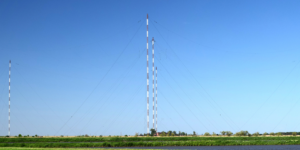
The researchers’ breakthrough could help usher in the next generation of optical communications. (PHOTO CREDIT: Chris Kim)
Han and Leia. George and Amal. Kermit and Miss Piggy. Gomez and Morticia. History’s greatest couples rely on communication to make them so strong their power cannot be denied.
But that’s not just true for people (or Muppets), it’s also true for lasers.
According to new research from the USC Viterbi School of Engineering, recently published in Nature Photonics, adding two lasers together as a sort of optical “it couple” promises to make wireless communications faster and more secure than ever before. But first, a little background.
Most laser-based communications — think fiber optics, commonly used for things like high-speed internet — is transmitted in the form of a laser (optical) beam traveling through a cable. Optical communications is exceptionally fast but is limited by the fact that it must travel through physical cables. Bringing the high-capacity capabilities of lasers to untethered and roving applications – such as to airplanes, drones, submarines, and satellites – is truly exciting and potentially game-changing.
FSOC cuts the cord of optical communications and allows it to travel freely through the atmosphere like radio waves do.
The USC Viterbi researchers have gotten us one step closer to that feat by focusing on something called Free Space Optical Communication (FSOC). This is no small feat, and it is a challenge researchers have been working on for some time. One major roadblock has been something called “atmospheric turbulence.”
As a single optical laser beam carrying information travels through the air, it experiences natural turbulence, much like a plane does. Wind and temperature changes in the atmosphere around it cause the beam to become less stable. Our inability to control that turbulence is what has prevented FSOC from advancing in performance similar to radio and optical fiber systems. Leaving us stuck with slower old radio waves for most wireless communication.
“While FSOC has been around a while, it has been a fundamental challenge to efficiently recover information from an optical beam that has been affected by atmospheric turbulence,” said Runzhou Zhang, the lead author and a Ph.D. student at USC Viterbi’s Optical Communications Laboratory in the Ming Hsieh Department of Electrical and Computer Engineering.
The researchers made an advance to solving this problem by sending a second laser beam (called a “pilot” beam) traveling along with the first to act as a partner. Traveling as a couple, the two beams are sent through the same air, experience the same turbulence, and have the same distortion. If only one beam is sent, the receiver must calculate all the distortion the beam experienced along the way before it can decode the data. This severely limits the system’s performance.
But, when the pilot beam travels alongside the original beam, the distortion is automatically removed. Like Kermit duetting “Rainbow Connection” with Miss Piggy, the information in that beam arrives at its destination clear, crisp and easy to understand.
From an engineering perspective, this accomplishment is no small feat. “The problem with radio waves, our current best bet for most wireless communication, is that it is much slower in data rate and much less secure than optical communications,” said Alan Willner, team lead on the paper and USC Viterbi professor of electrical and computer engineering. “With our new approach, we are one step closer to mitigating turbulence in high-capacity optical links.”
Perhaps most impressively, the researchers did not solve this problem with a new device or material. They simply looked at the physics and changed their perspective. “We used the underlying physics of a well-known device called a photo detector, usually used for detecting intensity of light, and realized it could be used in a new way to make an advance towards solving the turbulence problem for laser communication systems,” said Zhang.
Think about it this way: When Kermit and Miss Piggy sing their song, both their voices get distorted through the air in a similar way. That makes sense; they’re standing right next to each other, and their sound is traveling through the same atmosphere. What this photo detector does is turn the distortion of Kermit’s voice into the opposite of the distortion for Miss Piggy’s voice. Now, when they are mixed back together, the distortion is automatically canceled in both voices and we hear the song clearly and crisply.
With this newly realized application of physics, the team plans to continue exploring how to make the performance even better. “We hope that our approach will one day enable higher-performance and secure wireless links,” said Willner. Such links may be used for anything from high-resolution imaging to high-performance computing.
Published on October 12th, 2021
Last updated on October 12th, 2021










